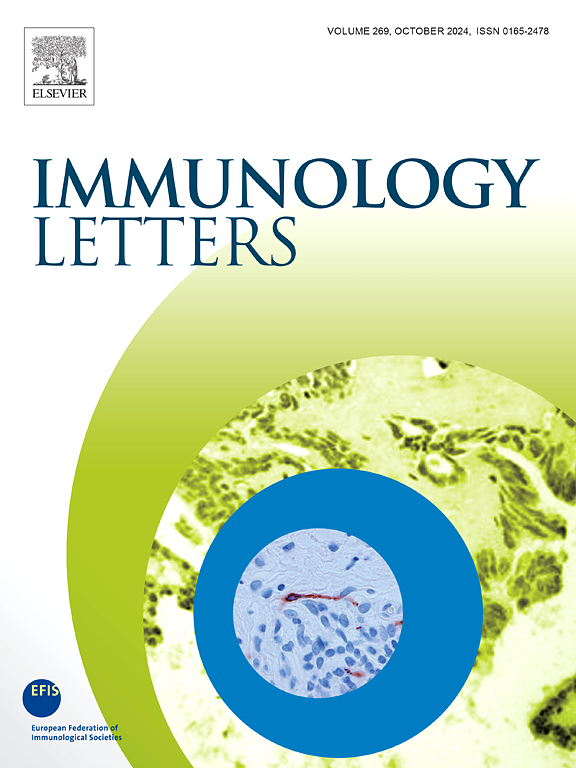CVID患者脾肿大与巨细胞病毒复制、免疫细胞和功能改变有关。
IF 2.8
4区 医学
Q3 IMMUNOLOGY
引用次数: 0
摘要
背景:脾肿大是常见的非感染性免疫缺陷(CVID)的表现,与特定的临床和免疫表型特征有关。目的:探讨CVID患者脾肿大、感染与免疫表型的关系。方法:入选32例CVID患者(其中脾肿大13例)。传染病检查包括详细的病史和来自常规诊断评估的数据,包括对血液和粪便样本的特定病毒学分析,以及结核病的QuantiFERON检测。采用多参数流式细胞术评价免疫表型。采用Prism和Jamovi软件进行统计分析。结果:40%的脾大性CVID (sCVID)患者检测到巨细胞病毒血症,而非sCVID患者不存在巨细胞病毒血症。在所有感染因子中,巨细胞病毒是唯一与脾肿大相关的感染因子(p=0.009)。将巨细胞病毒复制作为CVID中脾肿大的一个致病因素,这与脾肿大是急性巨细胞病毒感染的标志这一认识是一致的,并且可以帮助解释目前CVID队列中75%的其他原因不明的脾肿大。流式细胞分析证实,sCVID患者与非sCVID患者相比,NK细胞数量和活化减少,循环炎症前体(Lin-CD16+)减少,T细胞活化增加(由HLA-DR/CD69/CD38表达定义)。结论:CVID患者脾肿大可能与巨细胞病毒复制有关。CMV+ sCVID中NK细胞、炎症前体细胞和T细胞失衡的联合鉴定表明,在sCVID患者的一个亚群中,可能存在前体细胞水平的联合细胞缺陷。当整合到日常临床管理时,巨细胞病毒血症可能成为患者特征和分层的有用附加参数。本文章由计算机程序翻译,如有差异,请以英文原文为准。
Splenomegaly in CVID patients associates with CMV replication and alterations of immune cells and functions
Background
Splenomegaly represents a frequent non-infectious manifestation in Common Variable Immunodeficiency (CVID) and associates with specific clinical and immunophenotypic characteristics.
Objective
To investigate the association between splenomegaly, infections, and immunophenotype in CVID patients.
Methods
A cohort of 32 CVID patients (13 with splenomegaly) was enrolled. Infectious workup encompassed a detailed medical history and data derived from routine diagnostic assessments including specific virological analysis of blood and stool samples, and QuantiFERON assay for tuberculosis. Immunophenotype was assessed by multiparametric flow cytometry. Statistical analyses were performed using Prism and Jamovi software.
Results
CMV viraemia was detected in 40 % of splenomegalic CVID (sCVID) and was absent in non-sCVID patients. Of all infectious agents, CMV was the only one associated with splenomegaly (p = 0.009). The inclusion of CMV replication as a causative factor for splenomegaly in CVID is in line with the knowledge that splenomegaly is a hallmark of acute CMV infection and could help explain in the present CVID cohort 75 % of otherwise unexplained splenomegalies. Flow cytometric analysis in sCVID vs. non-sCVID confirmed decreases in NK cell numbers and activation, in circulating inflammatory precursors (Lin−CD16+), and increased T cell activation as defined by HLA-DR/CD69/CD38 expression.
Conclusion
Splenomegaly in CVID patients may associate also with CMV replication. The combined identification in CMV+ sCVID of NK cell, inflammatory precursor and T cell imbalances suggests a possible combined cellular defect at precursor level in a subset of sCVID patients. When integrated into everyday clinical management, CMV viraemia could become a useful additional parameter for patient characterization and stratification.
求助全文
通过发布文献求助,成功后即可免费获取论文全文。
去求助
来源期刊

Immunology letters
医学-免疫学
CiteScore
7.60
自引率
0.00%
发文量
86
审稿时长
44 days
期刊介绍:
Immunology Letters provides a vehicle for the speedy publication of experimental papers, (mini)Reviews and Letters to the Editor addressing all aspects of molecular and cellular immunology. The essential criteria for publication will be clarity, experimental soundness and novelty. Results contradictory to current accepted thinking or ideas divergent from actual dogmas will be considered for publication provided that they are based on solid experimental findings.
Preference will be given to papers of immediate importance to other investigators, either by their experimental data, new ideas or new methodology. Scientific correspondence to the Editor-in-Chief related to the published papers may also be accepted provided that they are short and scientifically relevant to the papers mentioned, in order to provide a continuing forum for discussion.
 求助内容:
求助内容: 应助结果提醒方式:
应助结果提醒方式:


